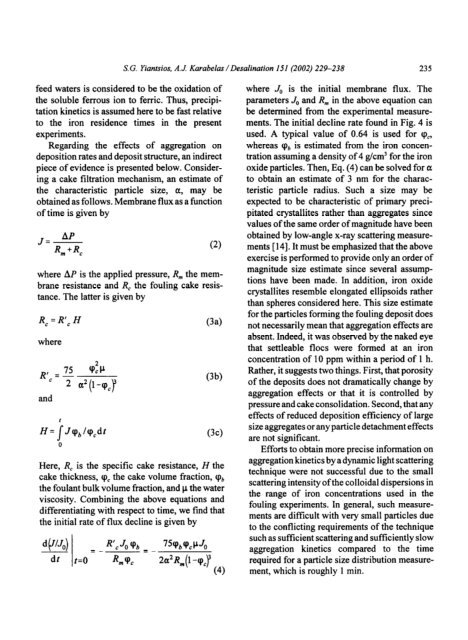An assessment of the Silt Density Index based on RO membrane ...
An assessment of the Silt Density Index based on RO membrane ...
An assessment of the Silt Density Index based on RO membrane ...
Create successful ePaper yourself
Turn your PDF publications into a flip-book with our unique Google optimized e-Paper software.
S.G. Yiantsios, A.J. Karabelas / Desalinati<strong>on</strong> 151 (2002) 229-238 235<br />
feed waters is c<strong>on</strong>sidered to be <str<strong>on</strong>g>the</str<strong>on</strong>g> oxidati<strong>on</strong> <str<strong>on</strong>g>of</str<strong>on</strong>g><br />
<str<strong>on</strong>g>the</str<strong>on</strong>g> soluble ferrous i<strong>on</strong> to ferric. Thus, precipitati<strong>on</strong><br />
kinetics is assumed here to be fast relative<br />
to <str<strong>on</strong>g>the</str<strong>on</strong>g> ir<strong>on</strong> residence times in <str<strong>on</strong>g>the</str<strong>on</strong>g> present<br />
experiments.<br />
Regarding <str<strong>on</strong>g>the</str<strong>on</strong>g> effects <str<strong>on</strong>g>of</str<strong>on</strong>g> aggregati<strong>on</strong> <strong>on</strong><br />
depositi<strong>on</strong> rates and deposit structure, an indirect<br />
piece <str<strong>on</strong>g>of</str<strong>on</strong>g> evidence is presented below. C<strong>on</strong>sidering<br />
a cake filtrati<strong>on</strong> mechanism, an estimate <str<strong>on</strong>g>of</str<strong>on</strong>g><br />
<str<strong>on</strong>g>the</str<strong>on</strong>g> characteristic particle size, a, may be<br />
obtained as follows. Membrane flux as a functi<strong>on</strong><br />
<str<strong>on</strong>g>of</str<strong>on</strong>g> time is given by<br />
J- -- A’<br />
where AP is <str<strong>on</strong>g>the</str<strong>on</strong>g> applied pressure, R, <str<strong>on</strong>g>the</str<strong>on</strong>g> <strong>membrane</strong><br />
resistance and R, <str<strong>on</strong>g>the</str<strong>on</strong>g> fouling cake resistance.<br />
The latter is given by<br />
R, = R’, H (W<br />
where<br />
R’ = 2 (pap<br />
c<br />
and<br />
2 a2(l-cp,Y<br />
t<br />
H = s<br />
J(p,lcp,dt<br />
0<br />
(3b)<br />
(3c)<br />
Here, R, is <str<strong>on</strong>g>the</str<strong>on</strong>g> specific cake resistance, H <str<strong>on</strong>g>the</str<strong>on</strong>g><br />
cake thickness, qc <str<strong>on</strong>g>the</str<strong>on</strong>g> cake volume fracti<strong>on</strong>, (Pi<br />
<str<strong>on</strong>g>the</str<strong>on</strong>g> foulant bulk volume fracti<strong>on</strong>, and p <str<strong>on</strong>g>the</str<strong>on</strong>g> water<br />
viscosity. Combining <str<strong>on</strong>g>the</str<strong>on</strong>g> above equati<strong>on</strong>s and<br />
differentiating with respect to time, we find that<br />
<str<strong>on</strong>g>the</str<strong>on</strong>g> initial rate <str<strong>on</strong>g>of</str<strong>on</strong>g> flux decline is given by<br />
q/Jo)<br />
= _ R’c Jo % = _ %AJc~Jo<br />
dt t=O %% 2~2%(1-%~ ,.\<br />
(4)<br />
where Jo is <str<strong>on</strong>g>the</str<strong>on</strong>g> initial <strong>membrane</strong> flux. The<br />
parameters Jo and R,,, in <str<strong>on</strong>g>the</str<strong>on</strong>g> above equati<strong>on</strong> can<br />
be determined from <str<strong>on</strong>g>the</str<strong>on</strong>g> experimental measurements.<br />
The initial decline rate found in Fig. 4 is<br />
used. A typical value <str<strong>on</strong>g>of</str<strong>on</strong>g> 0.64 is used for cp=,<br />
whereas (Pi is estimated from <str<strong>on</strong>g>the</str<strong>on</strong>g> ir<strong>on</strong> c<strong>on</strong>centrati<strong>on</strong><br />
assuming a density <str<strong>on</strong>g>of</str<strong>on</strong>g> 4 g/cm3 for <str<strong>on</strong>g>the</str<strong>on</strong>g> ir<strong>on</strong><br />
oxide particles. Then, Eq. (4) can be solved for a<br />
to obtain an estimate <str<strong>on</strong>g>of</str<strong>on</strong>g> 3 nm for <str<strong>on</strong>g>the</str<strong>on</strong>g> characteristic<br />
particle radius. Such a size may be<br />
expected to be characteristic <str<strong>on</strong>g>of</str<strong>on</strong>g> primary precipitated<br />
crystallites ra<str<strong>on</strong>g>the</str<strong>on</strong>g>r than aggregates since<br />
values <str<strong>on</strong>g>of</str<strong>on</strong>g> <str<strong>on</strong>g>the</str<strong>on</strong>g> same order <str<strong>on</strong>g>of</str<strong>on</strong>g> magnitude have been<br />
obtained by low-angle x-ray scattering measurements<br />
[ 141. It must be emphasized that <str<strong>on</strong>g>the</str<strong>on</strong>g> above<br />
exercise is performed to provide <strong>on</strong>ly an order <str<strong>on</strong>g>of</str<strong>on</strong>g><br />
magnitude size estimate since several assumpti<strong>on</strong>s<br />
have been made. In additi<strong>on</strong>, ir<strong>on</strong> oxide<br />
crystallites resemble el<strong>on</strong>gated ellipsoids ra<str<strong>on</strong>g>the</str<strong>on</strong>g>r<br />
than spheres c<strong>on</strong>sidered here. This size estimate<br />
for <str<strong>on</strong>g>the</str<strong>on</strong>g> particles forming <str<strong>on</strong>g>the</str<strong>on</strong>g> fouling deposit does<br />
not necessarily mean that aggregati<strong>on</strong> effects are<br />
absent. Indeed, it was observed by <str<strong>on</strong>g>the</str<strong>on</strong>g> naked eye<br />
that settleable floes were formed at an ir<strong>on</strong><br />
c<strong>on</strong>centrati<strong>on</strong> <str<strong>on</strong>g>of</str<strong>on</strong>g> 10 ppm within a period <str<strong>on</strong>g>of</str<strong>on</strong>g> 1 h.<br />
Ra<str<strong>on</strong>g>the</str<strong>on</strong>g>r, it suggests two things. First, that porosity<br />
<str<strong>on</strong>g>of</str<strong>on</strong>g> <str<strong>on</strong>g>the</str<strong>on</strong>g> deposits does not dramatically change by<br />
aggregati<strong>on</strong> effects or that it is c<strong>on</strong>trolled by<br />
pressure and cake c<strong>on</strong>solidati<strong>on</strong>. Sec<strong>on</strong>d, that any<br />
effects <str<strong>on</strong>g>of</str<strong>on</strong>g> reduced depositi<strong>on</strong> efficiency <str<strong>on</strong>g>of</str<strong>on</strong>g> large<br />
size aggregates or any particle detachment effects<br />
are not significant.<br />
Efforts to obtain more precise informati<strong>on</strong> <strong>on</strong><br />
aggregati<strong>on</strong> kinetics by a dynamic light scattering<br />
technique were not successful due to <str<strong>on</strong>g>the</str<strong>on</strong>g> small<br />
scattering intensity <str<strong>on</strong>g>of</str<strong>on</strong>g> <str<strong>on</strong>g>the</str<strong>on</strong>g> colloidal dispersi<strong>on</strong>s in<br />
<str<strong>on</strong>g>the</str<strong>on</strong>g> range <str<strong>on</strong>g>of</str<strong>on</strong>g> ir<strong>on</strong> c<strong>on</strong>centrati<strong>on</strong>s used in <str<strong>on</strong>g>the</str<strong>on</strong>g><br />
fouling experiments. In general, such measurements<br />
are difficult with very small particles due<br />
to <str<strong>on</strong>g>the</str<strong>on</strong>g> c<strong>on</strong>flicting requirements <str<strong>on</strong>g>of</str<strong>on</strong>g> <str<strong>on</strong>g>the</str<strong>on</strong>g> technique<br />
such as sufficient scattering and sufficiently slow<br />
aggregati<strong>on</strong> kinetics compared to <str<strong>on</strong>g>the</str<strong>on</strong>g> time<br />
required for a particle size distributi<strong>on</strong> measurement,<br />
which is roughly 1 min.

















